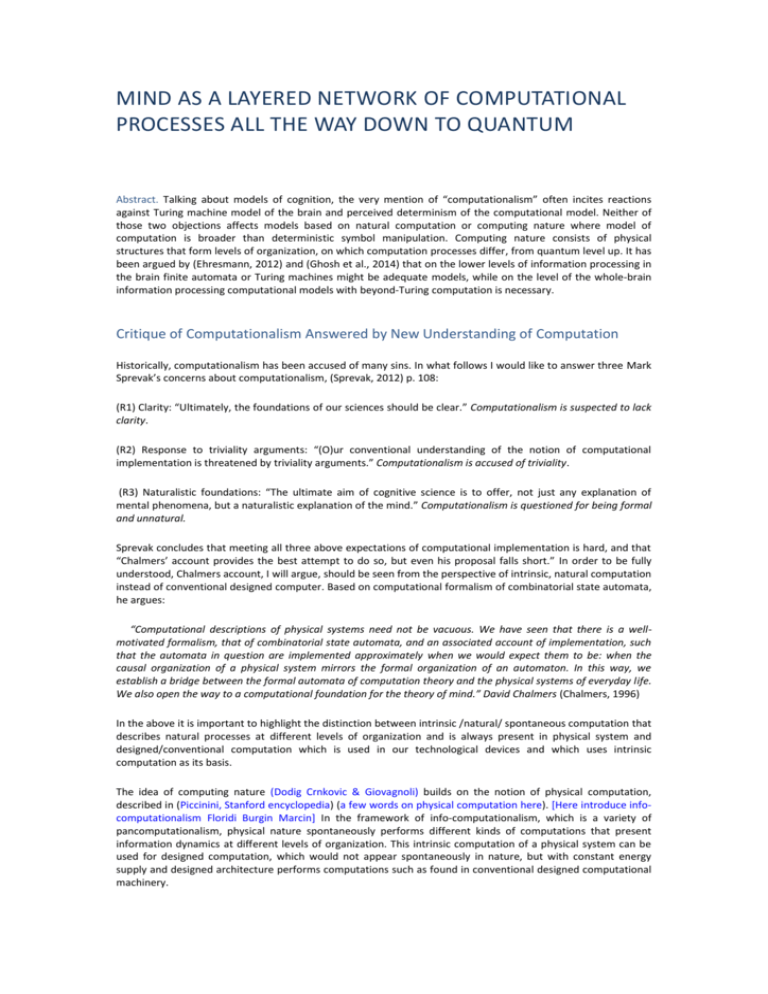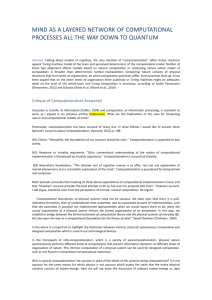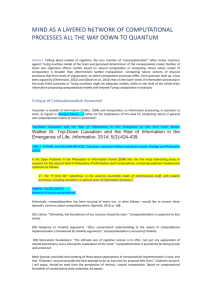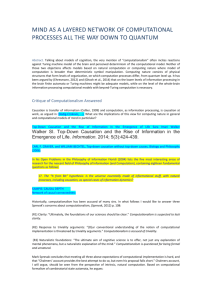IACAP 2014-COMPUTATIONAL MIND-20140806
advertisement

MIND AS A LAYERED NETWORK OF COMPUTATIONAL PROCESSES ALL THE WAY DOWN TO QUANTUM Abstract. Talking about models of cognition, the very mention of “computationalism” often incites reactions against Turing machine model of the brain and perceived determinism of the computational model. Neither of those two objections affects models based on natural computation or computing nature where model of computation is broader than deterministic symbol manipulation. Computing nature consists of physical structures that form levels of organization, on which computation processes differ, from quantum level up. It has been argued by (Ehresmann, 2012) and (Ghosh et al., 2014) that on the lower levels of information processing in the brain finite automata or Turing machines might be adequate models, while on the level of the whole-brain information processing computational models with beyond-Turing computation is necessary. Critique of Computationalism Answered by New Understanding of Computation Historically, computationalism has been accused of many sins. In what follows I would like to answer three Mark Sprevak’s concerns about computationalism, (Sprevak, 2012) p. 108: (R1) Clarity: “Ultimately, the foundations of our sciences should be clear.” Computationalism is suspected to lack clarity. (R2) Response to triviality arguments: “(O)ur conventional understanding of the notion of computational implementation is threatened by triviality arguments.” Computationalism is accused of triviality. (R3) Naturalistic foundations: “The ultimate aim of cognitive science is to offer, not just any explanation of mental phenomena, but a naturalistic explanation of the mind.” Computationalism is questioned for being formal and unnatural. Sprevak concludes that meeting all three above expectations of computational implementation is hard, and that “Chalmers’ account provides the best attempt to do so, but even his proposal falls short.” In order to be fully understood, Chalmers account, I will argue, should be seen from the perspective of intrinsic, natural computation instead of conventional designed computer. Based on computational formalism of combinatorial state automata, he argues: “Computational descriptions of physical systems need not be vacuous. We have seen that there is a wellmotivated formalism, that of combinatorial state automata, and an associated account of implementation, such that the automata in question are implemented approximately when we would expect them to be: when the causal organization of a physical system mirrors the formal organization of an automaton. In this way, we establish a bridge between the formal automata of computation theory and the physical systems of everyday life. We also open the way to a computational foundation for the theory of mind.” David Chalmers (Chalmers, 1996) In the above it is important to highlight the distinction between intrinsic /natural/ spontaneous computation that describes natural processes at different levels of organization and is always present in physical system and designed/conventional computation which is used in our technological devices and which uses intrinsic computation as its basis. The idea of computing nature (Dodig Crnkovic & Giovagnoli) builds on the notion of physical computation, described in (Piccinini, Stanford encyclopedia) (a few words on physical computation here). [Here introduce infocomputationalism Floridi Burgin Marcin] In the framework of info-computationalism, which is a variety of pancomputationalism, physical nature spontaneously performs different kinds of computations that present information dynamics at different levels of organization. This intrinsic computation of a physical system can be used for designed computation, which would not appear spontaneously in nature, but with constant energy supply and designed architecture performs computations such as found in conventional designed computational machinery. Natural/Intrinsic Computation and Physical Implementation of Computational System Why is natural computationalism not vacuous in spite of the underlying assumption of the whole of the universe being computational? It is not vacuous for the same reason for which physics is not vacuous which makes the claim that the entire physical universe consists of matter-energy and builds on the same elementary building blocks – elementary particles. Here we will not enter the discussion of ordinary matter-energy vs. dark matterenergy. Those are all considered to be the same kind of phenomena – natural phenomena that are assumed to be universal in nature. The principle of universal validity of physical laws does not make them vacuous. Thinking of computation as implementation of physical laws on the fundamental level makes it more obvious that computation can be seen as the bass of all dynamics in nature. Introduction to Focus Issue: Intrinsic and Designed Computation: Information Processing in Dynamical Systems— Beyond the Digital Hegemony James P. Crutchfield,1,a! William L. Ditto,2,b! and Sudeshna Sinha3,c! Causation is transfer of information (Collier, 1999) and computation, as information processing, is causation at work, as argued in (Dodig-Crnkovic, …). What are the implications of this view for computing nature in general and computational models of mind in particlular? Top-Down Causation and the Rise of Information in the Emergence of Life Sara Imari Walker Walker SI. Top-Down Causation and the Rise of Information in the Emergence of Life. Information. 2014; 5(3):424-439. CARL F. CRAVER, and WILLIAM BECHTEL, Top-down causation without top-down causes, Biology and Philosophy (2006) In his Open Problems in the Philosophy of Information Floridi (2004) lists the five most interesting areas of research for the nascent field of Philosophy of Information (and Computation), containing eighteen fundamental questions as follows: 17. The “It from Bit” hypothesis: Is the universe essentially made of informational stuff, with natural processes, including causation, as special cases of information dynamics? KAMPIS: CAUSAL DEPTH Network of causal connectedness Andre Ehresmann talks about synonymity Memory Evolutive Systems However, Marcin Miłkowski suggests “the physical implementation of a computational system – and its interaction with the environment – lies outside the scope of computational explanation”. ”For a pancomputationalist, this means that there must be a distinction between lower-level, or basic, computations and the higher level ones. Should pancomputationalism be unable to mark this distinction, it will be explanatorily vacuous.” (Miłkowski, 2007) From the above I infer that the model of computation, which Miłkowski assumes is a top-down, designed computation. Even though he rightly argues that neural networks and even dynamical systems can be understood as computational, Miłkowski does not think of intrinsic computation as grounded in physical process driven by causal mechanism, characteristics of computing nature. The problem of grounding. Where the following question comes from? If we would apply the above logic, we would demand from physicists to explain where matter comes from. Where do the elementary particles come from? They are simply empirical facts for which we have enough evidence. We might not know all of their properties and relationships, we might not know all of them, but we can be sure at least that they exist. The bottom layer for the computational universe is the bottom layer of its material substrate, which with constant progress of physics is becoming more and more fine-grained. Mind as a process and Computational Models of Mind Of all computational approaches, the most controversial are the computational models of mind. There exists historically a huge variety of models, some of them taking mind to be a kind of substance opposed to matter. It is more natural for computational approaches to consider mind as a process, a complex process of computation on many different levels of organization. “To sum up: mind is a set of processes distinguished from others through their control by an immanent end. (…) At one extreme it dwindles into mere life, which is incipient mind. At the other extreme it vanishes in the clouds; it does not yet appear what we shall be. Mind as it exists in ourselves is on an intermediate level.” (Blanshard, 1941) Within info-computational framework, cognition is understood as synonymous with process of life, a view that even Brand Blanshard adopted. Following Maturana and Varela’s argument from 1980 (Maturana & Varela, 1980), we can understand the entire living word as possessing cognition of various degrees of complexity. In that sense bacteria possess rudimentary cognition expressed in quorum sensing and other collective phenomena based on information communication and information processing. Brain of a complex organism consists of neurons that are networked communication computational units. Signalling and information processing modes of a brain are much more complex and consist of more computational layers than bacterial colony. Even though Maturana and Varela did not think of cognition as computation, the broader view of computation as found in info-computationalism is capable of representing processes of life as studied in bioinformatics and biocomputation. Relation between mind and cognition [Marcin’s book] http://www.scholarpedia.org/article/Mind-body_problem:_New_approaches Starting with mind as life itself, a single cell, and studying increasingly more complex organisms such as rotifers (which have around a thousand cells, of which a quarter constitute their nervous system with brain) or the tiny Megaphragma mymaripenne wasps (that are smaller than a single-celled amoebas and yet have nervous system and brains) – with more and more layers of cognitive information-processing architectures we can follow the evolution of mind as a capacity of a living organism to act on their own behalf: “(W)herever mind is present, there the pursuit of ends is present”. (…) ”Mental activity is the sort of activity everywhere whose reach exceeds its grasp.” (…) “Now mind, at all of its levels and in all of its manifestations, is a process of this kind” [i.e. a drive toward a special end]. (Blanshard, 1941) And the process powering this goal-directed behavior on a variety of levels of organization in living organisms is information self-organization. Andre Ehresmann (Ehresmann, 2012) proposes the model of brain where lower levels are made of Turing machines while the higher levels of cognitive activity are non-Turing, based on the fact that the same symbol has several possible interpretations. In contrast, Subrata Ghosh et al. (Ghosh et al., 2014) remarkable brain model demonstrates how mind can be modelled from the level of quantum field theory up to the macroscopic whole-brain, in twelve levels of computational architecture, based on computing beyond Turing model. REFERENCES Blanshard, B. (1941). The Nature of Mind. The Journal of Philosophy, 38(8), 207–216. Chalmers, D. J. (1996). Does a Rock Implement Every Finite-State Automaton? Synthese, 108, 309–33. Collier, J. (1999). Causation is the transfer of information. In H. Sankey (Ed.), Causation, natural laws and explanation (pp. 279–331). Dordrecht: Kluwer. Ehresmann, A. C. (2012). MENS, an Info-Computational Model for (Neuro-)cognitive Systems Capable of Creativity. Entropy, 14, 1703–1716. Ghosh, S., Aswani, K., Singh, S., Sahu, S., Fujita, D., & Bandyopadhyay, A. (2014). Design and Construction of a Brain-Like Computer: A New Class of Frequency-Fractal Computing Using Wireless Communication in a Supramolecular Organic, Inorganic System. Information, 5(1), 28–100. doi:10.3390/info5010028 Maturana, H., & Varela, F. (1980). Autopoiesis and cognition: the realization of the living. Dordrecht Holland: D. Reidel Pub. Co. Miłkowski, M. (2007). Is computationalism trivial? In G. Dodig-Crnkovic & S. Stuart (Eds.), Computation, Information, Cognition – The Nexus and the Liminal (pp. 236–246). Newcastle UK: Cambridge Scholars Press. Sprevak, M. (2012). Three challenges to Chalmers on computational implementation. Journal of Cognitive Science, 13(2), 107–143. From the mail to Terry Deacon The central claim that I wish to reflect upon is how a system "registers"* information (and a connected question why it "registers" some information and not the other). From Deacon’s text (private communication): "The far-from-equilibrium case is of major importance also because it provides the foundation for an analysis of the nature of an interpretive process (see next section). A simple exemplar of a far-from-equilibrium information medium is a metal detector." There is for example connection to: Kaneko, K. and Tsuda, I. "Complex systems: chaos and beyond. A constructive approach with applications in life sciences", Springer, Berlin/Heidelberg, 2001. http://books.google.se/books?id=7lcINfgupggC&pg=PA265&dq=Complex+Systems:+C haos+and+Beyond+by+K.+Kaneko;+I.+Tsuda&hl=en&sa=X&ei=5RVHU8f-E6SbygGmuYGwCA &ved=0CC0Q6AEwAA#v=onepage&q=Complex%20Systems%3A%20Chaos%20and%20Beyond%20 by%20K.%20Kaneko%3B%20I.%20Tsuda&f=false They discuss different topics, but this seems to me be of interest in connection to Deacon’s paper: Dynamics of living organism creates a sensitive state that reacts on the changes in the environment. “Those data are in accordance with the dynamic viewpoint of the brain as proposed by Tsuda, which can be summarized as follows: a neuron and a neuron assembly are not structured to reveal a single function, but structured such that they can implement multiple functions according to the internal states of the brain and the external environment. Furthermore, these activities should reveal temporally complex behavior, which perhaps is related to the chaotic itinerancy. Thus the study of the relational dynamics among the elements involved in the information processing of the brain will be an important issue.” P.18 This in turn may be expressed in terms of von Foersters notions of eigenvalues (stable structures) and eigenbehaviors (stable behaviors established in the interaction with the environment): “ Any system, cognitive or biological, which is able to relate internally, selforganized, stable structures (eigenvalues) to constant aspects of its own interaction with an environment can be said to observe eigenbehavior. Such systems are defined as organizationally closed because their stable internal states can only be defined in terms of the overall dynamic structure that supports them.” (Rocha 1998: 342) Rocha L. M. (1998) Selected self-organization and the semiotics of evolutionary systems. In: Salthe S., Van de Vijver G. & Delpos M. (eds.) Evolutionary systems: Biological and epistemological perspectives on selection and self-organization. Kluwer, Dordrecht: p. 342 Similarly, the following thought may be found in Gilbert Simondon's discussion of form-information relationship: "The notion of form must be replaced by that of information, which implies the existence of a system in metastable equilibrium that can individuate; information, the difference in shape, is never a single term, but the meaning that arises from a disparation (disappearance)." Simondon, Gilbert (2007) L'individuation psychique et collective. Paris: Editions Aubier (p. 28, translation by Andrew Iliadis) In the above picture of a metastable state capable of reacting to the relevant changes in the environment, two things are particularly interesting (apart from the meta-stability itself): time-dependence (dynamics) and fractality. Both are addressed in a radically new approach to the modeling of a whole brain in the following article by (Ghosh et al., 2014): Ghosh, Subrata; Aswani, Krishna; Singh, Surabhi; Sahu, Satyajit; Fujita, Daisuke; Bandyopadhyay, Anirban. 2014. "Design and Construction of a Brain-Like Computer: A New Class of Frequency-Fractal Computing Using Wireless Communication in a Supramolecular Organic, Inorganic System." Information 5, no. 1: 28-100. http://www.mdpi.com/2078-2489/5/1/28 What seems interesting in this context is that the central point in the above model is the collective time behavior and (fractal) frequencies at number of different levels of organization. (Ghosh et al., 2014) suggest a possibility of connection between levels from QFT (Quantum Field Theory) up to macroscopic levels based on time dependence of physical oscillators involved. It might not be an adequate model of a brain, but as Bohr model of atom it can contain some interesting insights. (refer to Basti here) “Here, we introduce a new class of computer which does not use any circuit or logic gate. In fact, no program needs to be written: it learns by itself and writes its own program to solve a problem. Gödel's incompleteness argument is explored here to devise an engine where an astronomically... Abstract: Here, we introduce a new class of computer which does not use any circuit or logic gate. In fact, no program needs to be written: it learns by itself and writes its own program to solve a problem. Gödel’s incompleteness argument is explored here to devise an engine where an astronomically large number of “if-then” arguments are allowed to grow by self-assembly, based on the basic set of arguments written in the system, thus, we explore the beyond Turing path of computing but following a fundamentally different route adopted in the last half-a- century old non-Turing adventures. Our hardware is a multilayered seed structure. If we open the largest seed, which is the final hardware, we find several computing seed structures inside, if we take any of them and open, there are several computing seeds inside. We design and synthesize the smallest seed, the entire multilayered architecture grows by itself. The electromagnetic resonance band of each seed looks similar, but the seeds of any layer shares a common region in its resonance band with inner and upper layer, hence a chain of resonance bands is formed (frequency fractal) connecting the smallest to the largest seed (hence the name invincible rhythm or Ajeya Chhandam in Sanskrit). The computer solves intractable pattern search (Clique) problem without searching, since the right pattern written in it spontaneously replies back to the questioner. To learn, the hardware filters any kind of sensory input image into several layers of images, each containing basic geometric polygons (fractal decomposition), and builds a network among all layers, multi-sensory images are connected in all possible ways to generate “if” and “then” argument. Several such arguments and decisions (phase transition from “if” to “then”) selfassemble and form the two giant columns of arguments and rules of phase transition. Any input question is converted into a pattern as noted above, and these two astronomically large columns project a solution. The driving principle of computing is synchronization and desynchronization of network paths, the system drives towards highest density of coupled arguments for maximum matching. Memory is located at all layers of the hardware. Learning, computing occurs everywhere simultaneously. Since resonance chain connects all computing seeds, wireless processing is feasible without a screening effect. The computing power is increased by maximizing the density of resonance states and bandwidth of the resonance chain together. We discovered this remarkable computing while studying the human brain, so we present a new model of the human brain in terms of an experimentally determined resonance chain with bandwidth 10−15 Hz (complete brain with all sensors) to 10+15 Hz (DNA) along with its implementation using a pure organic synthesis of entire computer (brain jelly) in our lab, software prototype as proof of concept and finally a new fourth circuit element (Hinductor) based beyond Complementary metaloxide semiconductor (CMOS) hardware is also presented. Keywords: Turing machine; Gödel’s incompleteness theorem; nonalgorithmic computing; self-assembly; wireless communication; antenna; receiver; electromagnetic resonance; synchronization; brainlike computer; creative machine; intelligent machine; conscious machine *This expression I borrow from Brian Cantwell Smith's "On the Origin of Objects" Top-down causation without top-down causes Carl F. Craver & William Bechtel Biology and Philosophy 22 (4):547-563 (2007) Abstract We argue that intelligible appeals to interlevel causes (top-down and bottom-up) can be understood, without remainder, as appeals to mechanistically mediated effects. Mechanistically mediated effects are hybrids of causal and constitutive relations, where the causal relations are exclusively intralevel. The idea of causation would have to stretch to the breaking point to accommodate interlevel causes. The notion of a mechanistically mediated effect is preferable because it can do all of the required work without appealing to mysterious interlevel causes. When interlevel causes can be translated into mechanistically mediated effects, the posited relationship is intelligible and should raise no special philosophical objections. When they cannot, they are suspect. The software/wetware distinction Comment on “Toward a computational framework for cognitive biology: Unifying approaches from cognitive neuroscience and comparative cognition” by W. Tecumseh Fitch DanielDennetta,b aTufts University, United States1 bSanta Fe Institute, United States2 Received23 May 2014; accepted26 May 2014 Fitch WT. Toward a computational framework for cognitive biology: unifying approaches from cognitive neuroscience and comparative cogni-tion. Phys Life Rev 2014. http://dx.doi.org/10.1016/j.plrev.2014.04.005[this issue]. « 3 » An MES gives a constructive model for a self-organized multi-scale cognitive system that is able to interact with its environment through information processing, such as a living organism or an artificial cognitive system. Its dynamics is modulated by the interactions of a network of specialized internal agents called co-regulators (CRs). Each CR operates at its own rhythm to collect and process external and/or internal information related to its function, and possibly to select appropriate procedures. The co-regulators operate with the help of a central, flexible memory containing the knowledge of the system, which they contribute to develop and adapt to a changing environment. « 4 » In an MES, a central role is played by the following properties of information processing in living systems: (i) The system not only processes isolated information items, but also takes their interactions into account by processing information patterns, that is patterns of interconnected information items. (ii) The MES satisfies a multiplicity principle (MP), asserting that several such information patterns may play the same functional role once actualized, with the possibility of a switch between them during processing operations. This principle formalizes the degeneracy property that is ubiquitous in biological systems, as emphasized by Edelman (1989; Edelman & Gally 2001). It permits Gregory Bateson’s sentence (Åò21) to be completed into “a difference that makes a difference, but also may not make a difference.” The MP is at the root of the flexibility and adaptability of an MES; it will also be responsible for the non-computability of its global dynamics. « 5 » Once actualized in the MES, an information pattern P will take its own identity as a new component cP of a higher complexity order, which “binds” the pattern, for instance as a record of P in the memory. The binding process is modeled by the categorical colimit operation (Kan 1958): cP becomes the colimit of P and also of each of the other functionallyequivalent information patterns; thus it acts as a multi-facetted component. Such multi-facetted components are constructed through successive complexification processes (Ehresmann & Vanbremeersch 2007). The complexification also constructs the links interconnecting two multi-facetted components cP and cQ. There are simple links, which bind together a cluster of links between the






